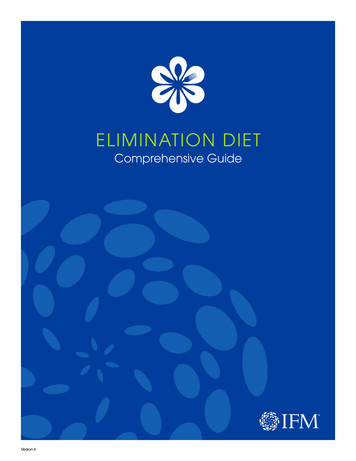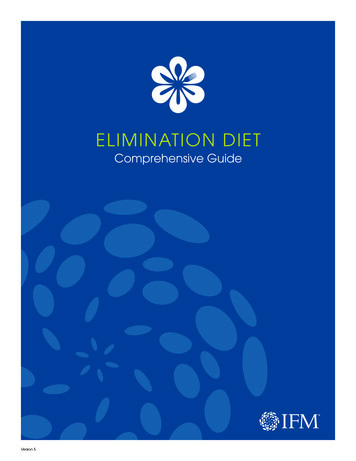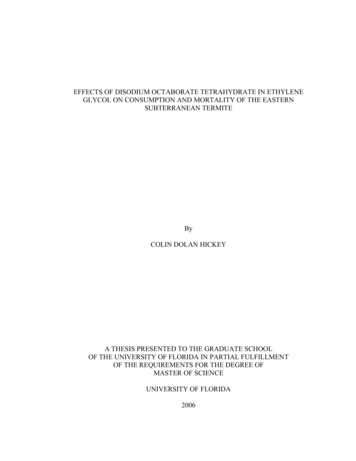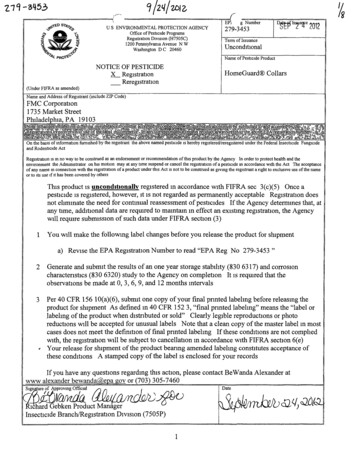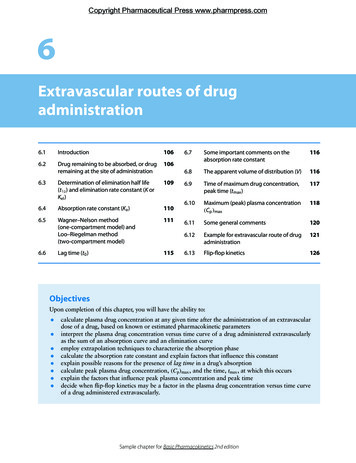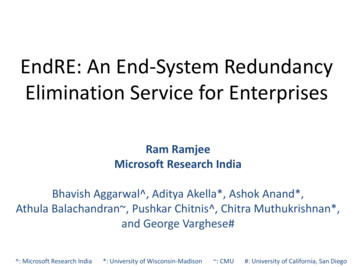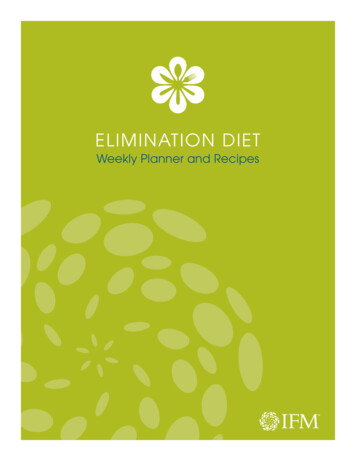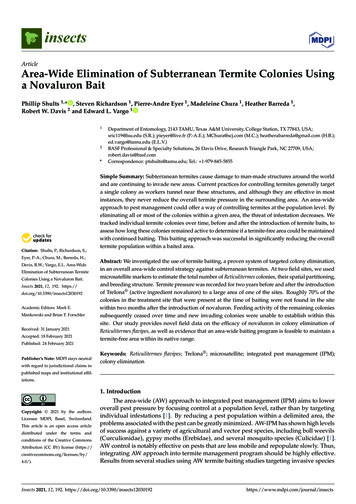
Transcription
insectsArticleArea-Wide Elimination of Subterranean Termite Colonies Usinga Novaluron BaitPhillip Shults 1, * , Steven Richardson 1 , Pierre-Andre Eyer 1 , Madeleine Chura 1 , Heather Barreda 1 ,Robert W. Davis 2 and Edward L. Vargo 112* Citation: Shults, P.; Richardson, S.;Eyer, P.-A.; Chura, M.; Barreda, H.;Davis, R.W.; Vargo, E.L. Area-WideElimination of Subterranean TermiteColonies Using a Novaluron Bait.Insects 2021, 12, 192. https://doi.org/10.3390/insects12030192Academic Editors: Mark E.Mankowski and Brian T. ForschlerReceived: 31 January 2021Accepted: 18 February 2021Published: 24 February 2021Publisher’s Note: MDPI stays neutralwith regard to jurisdictional claims inDepartment of Entomology, 2143 TAMU, Texas A&M University, College Station, TX 77843, USA;sric119@lsu.edu (S.R.); pieyer@live.fr (P.-A.E.); MChura@scj.com (M.C.); heatherabarreda@gmail.com (H.B.);ed.vargo@tamu.edu (E.L.V.)BASF Professional & Specialty Solutions, 26 Davis Drive, Research Triangle Park, NC 27709, USA;robert.davis@basf.comCorrespondence: ptshults@tamu.edu; Tel.: 1-979-845-5855Simple Summary: Subterranean termites cause damage to man-made structures around the worldand are continuing to invade new areas. Current practices for controlling termites generally targeta single colony as workers tunnel near these structures, and although they are effective in mostinstances, they never reduce the overall termite pressure in the surrounding area. An area-wideapproach to pest management could offer a way of controlling termites at the population level. Byeliminating all or most of the colonies within a given area, the threat of infestation decreases. Wetracked individual termite colonies over time, before and after the introduction of termite baits, toassess how long these colonies remained active to determine if a termite-free area could be maintainedwith continued baiting. This baiting approach was successful in significantly reducing the overalltermite population within a baited area.Abstract: We investigated the use of termite baiting, a proven system of targeted colony elimination,in an overall area-wide control strategy against subterranean termites. At two field sites, we usedmicrosatellite markers to estimate the total number of Reticulitermes colonies, their spatial partitioning,and breeding structure. Termite pressure was recorded for two years before and after the introductionof Trelona (active ingredient novaluron) to a large area of one of the sites. Roughly 70% of thecolonies in the treatment site that were present at the time of baiting were not found in the sitewithin two months after the introduction of novaluron. Feeding activity of the remaining coloniessubsequently ceased over time and new invading colonies were unable to establish within thissite. Our study provides novel field data on the efficacy of novaluron in colony elimination ofReticulitermes flavipes, as well as evidence that an area-wide baiting program is feasible to maintain atermite-free area within its native range.Keywords: Reticulitermes flavipes; Trelona ; microsatellite; integrated pest management (IPM);colony eliminationpublished maps and institutional affiliations.1. IntroductionCopyright: 2021 by the authors.Licensee MDPI, Basel, Switzerland.This article is an open access articledistributed under the terms andconditions of the Creative CommonsAttribution (CC BY) license (https://creativecommons.org/licenses/by/4.0/).The area-wide (AW) approach to integrated pest management (IPM) aims to loweroverall pest pressure by focusing control at a population level, rather than by targetingindividual infestations [1]. By reducing a pest population within a delimited area, theproblems associated with the pest can be greatly minimized. AW-IPM has shown high levelsof success against a variety of agricultural and vector pest species, including boll weevils(Curculionidae), gypsy moths (Erebidae), and several mosquito species (Culicidae) [1].AW control is notably effective on pests that are less mobile and repopulate slowly. Thus,integrating AW approach into termite management program should be highly effective.Results from several studies using AW termite baiting studies targeting invasive speciesInsects 2021, 12, 192. .mdpi.com/journal/insects
Insects 2021, 12, 1922 of 12of termites look encouraging (Coptotermes formosanus Shiraki in New Orleans, USA andReticulitermes flavipes Kollar in Santiago, Chile) [2–5]; however, more work is needed to testthe viability of this control strategy against different pest species of termites, as well asevaluate the efficacy of various commercially available termite baits.Subterranean termites are present throughout much of the world in both undisturbedand anthropogenic habitats. As decomposers of cellulose material, they provide valuable ecosystem services; however, they can also cause massive amounts of damage tohuman structures. In the United States alone, homeowners spend over 11 billion USDannually on subterranean termite control measures and damage repairs [6,7]. In addition, subterranean termites include highly invasive species rapidly spreading worldwide,such as C. formosanus, C. gestroi (Wassman) and Reticulitermes flavipes [8–13]. The genusReticulitermes contains the most widespread subterranean termite species in the U.S., aswell as some of the most damaging pest species: R. flavipes and R. virginicus Banks [14].Colonies of these species can contain hundreds of thousands or even millions of foragingtermites [15], and colony density can be as high as 300 colonies per hectare [16], althoughthis varies geographically and by habitat type [17]. With such a high colony density, manmade structures in these areas can be subject to an immense amount of termite pressure.Therefore, AW control may be of particular relevance to reducing termite pressure within agiven area.In general, new colonies of the subterranean termite R. flavipes are founded by a monogamous pair of primary reproductives. These primary reproductives disperse through flightand can populate new areas; however, newly founded colonies require years to fully mature [14]. Once established, colonies are generally stationary with workers radiating fromthe central nest to forage [16]. At this stage of the colony, workers are the offspring of theoutbred primary reproductives, which constitutes a simple family. When the primary queenor king dies, nymphs or workers can further develop into neotenic reproductives, whichcan extend the colony’s life span through inbreeding (extended-family colonies) [18–20].Sometimes, distinct colonies can merge into a single genetically diverse, yet cohesive,colony (mixed family) [21]. Overall, these differences in family types may greatly influencethe size of the colonies, and consequently their foraging range [19,22]. Throughout most ofthe southeastern US, roughly 65–85% of R. flavipes colonies are simple families, however,the proportion of simple-family colonies to extended- or mixed-family colonies variesdrastically in the northeast US and Louisiana [23]. As mentioned above, R. flavipes is alsoinvasive in large regions in France, Germany, Canada, and Chile and is continuing to expand to other areas [9,24–27]. In these invasive localities, colonies may be even larger thanwithin the native range due to low non-nestmate aggression, leading to a higher frequencyof colony fusion [28,29]. In addition, these colonies are often headed by numerous (upto hundreds) neotenics, which results in highly populated colonies. With such drasticvariation in the breeding structure and behavior of R. flavipes populations in both the nativeand invasive ranges, measures taken to control these termites could have varying levelsof success.The two most commonly used methods of controlling termite infestations are treatingthe soil adjacent to the structure with a liquid termiticide or installing bait stations [30–32].These site-specific control measures attempt to protect the structure from invading colonies,but the overall threat of re-infestation remains as neighboring colonies can move intothese vacated areas [33,34]. Termite baits are used as both curative and preventative measures against subterranean termites and have been shown to eliminate colonies [30,35,36].The active ingredients of most termite baits are chitin synthesis inhibitors (CSI), whichcause mortality in the workers when they return to the nest to molt and spreads throughthe colony through trophallaxis. Over time, the colony collapses and is presumed eliminated [37]. On average, colony elimination occurs after 3–6 months of bait consumptionwith a 90–100% efficacy rate [38]. As effective as termite baiting is, this strategy is usuallyused to target termite colonies associated with a structure without addressing the overallpest pressure in a larger area. Integrating baiting into an AW management program aims at
Insects 2021, 12, 1923 of 12eliminating most of the colonies within a large area, greatly reducing the threat of termitesattacking a structure [37]. This approach has shown that it is possible to significantlydecrease overall termite pressure over multiple city blocks [3,4,39,40], but most of theAW-IPM baiting programs have been centered on invasive populations of C. formosanusin the USA and R. flavipes in Chile. As native populations of subterranean termites haveincreased genetic diversity, face locally adapted pressures, and encounter a potentiallyhigher availability of suitable habitats, it is unclear to what extent AW baiting can beeffective. Additionally, nearly 80% of all field termite baiting trials have been conductedusing either hexaflumuron or noviflumuron, highlighting the need for testing other activeingredients to determine if these CSI baits can achieve similar results [38].In this study, we tested the viability of using Trelona Compressed Termite Bait (activeingredient novaluron) and the Advance Termite Baiting System (ATBS) to target andreduce the total number of subterranean termite colonies within a given area. For two years,we tracked the total number of Reticulitermes colonies and mapped their spatial partitioningto determine the baseline termite pressure in a delimited area. Colony differentiationwas genetically assessed using workers collected from the bait stations. Novaluron wasthen introduced to a large section of the treatment site, and colonies were tracked fortwo additional years. We estimated the time elapsed before the treated colonies collapsedas well as consumption of the CSI bait. Of the original termite colonies identified in thetreatment site, none remained after baits were applied and new colonies invading the sitewere not active for long. This study provides novel field data for colony elimination andsuccessful AW control using novaluron.2. Materials and Methods2.1. Field Site and CollectionsThis study was conducted in College Station, Texas at field sites located near theRollins Urban and Structural Entomology Facility. In February 2016, 200 ATBS termitestations were installed at two field sites (100 per site) with 5 m between each station(Figures 1 and 2). In each site, approximately half of the stations were placed withina wooded area and the other half were placed in an adjacent pasture. During initialinstallation and for the first 27 months of the study, all stations within these two sitescontained a set of two wooden monitoring blocks and blank (no active ingredient) termiteinspection cartridge (Figure S1). These blank cartridges contain the same cellulose baitmatrix as found in the commercially available product but without novaluron added. Thewooden monitoring blocks and inspection cartridges were replaced as needed due to mold,degradation, and termite consumption. Stations were inspected every other month, and,approximately 50 individuals were collected and stored in 95% ethanol from stations foundwith active termites. These samples were stored at 20 C for later genotyping and colonyassignment. For each station with termite activity, four auxiliary stations were placed 2.5 mfrom the main station in each cardinal direction. In May of 2018, 55 stations (yellow triangle(Figure 2)) with the highest termite activity in the treatment site ( 1400 m2 of wooded area(Figure 2)) had the wooden monitoring blocks and inspection cartridges replaced with twonovaluron bait cartridges (Figure S1). The remaining stations in the treatment site and allof the stations in the control site were left untreated (wooden monitoring blocks and blankinspection cartridges). Inspections were carried out monthly for the remaining 17 monthsof the study. Feeding on novaluron bait was determined by visual inspections to estimatethe amount of bait consumed. The mean number of active stations per inspection at eachsite was compared using a generalized linear model (GLM) with the interaction betweensite and pre-/post-treatment as fixed effects, followed by Tukey’s HSD in JMP 14.0 (SASsoftware, Cary, NC, USA).2.2. DNA Extraction, Genotyping & SequencingTotal DNA was extracted from eight workers from each collection sample following amodified Gentra PureGene protocol (Gentra Systems, Inc., Minneapolis, MN, USA). Two
Insects 2021, 12, 192Insects 2021, 12, x4 of 12highly polymorphic microsatellite markers (Rf21-1 and Rf24-2) were amplified for eachindividual following the method of Vargo 2000 [41]. The Rf21-1 primer set was fluorescentlylabeled using 6-FAM dye and the Rf24-4 was labeled using NED dye. DNA amplificationswere performed in a volume of 15 µL including 0.15 µL of MyTaq HS DNA polymerase(Bioline, Cincinnatri, OH, USA), 5 µL of MyTaq 5 reaction buffer (Bioline, Cincinnatri,OH, USA), 0.50 µL of each primer, and 1.0 µL of the DNA template. PCR was carriedout using a Bio-Rad thermocycler T100 (Bio-Rad, Hercules, CA, USA) using the followingprogram: initial denaturation step at 94 C (50 s) followed by 35 cycles at 94 C (50 s),55 C (2 min), and 72 C (2 min), with a final extension step at 72 C (5 min). PCR productswere visualized on an ABI 3500 genetic analyzer using a LIZ500 internal standard (AppliedBiosystems, Foster City, CA, USA). Allele labeling was performed using Geneious softwarev.9.1 [42]. A portion of the 16S gene region was sequenced from an individual workerfor each inferred colony collected in the first year to determine species. Further speciesof 12differentiation was assessed using species-specific microsatellite alleles on the Rf21-1 4andRf24-2 markers for three years (described below).Figure1.1. ColoniesColonies incolonieswereassignedto ato aFigurein thethe ear.IndividualIndividualcolonieswereassigned station (auxiliary stationsnumber within each site. White circles represent an individual ATBS number within each site. White circles represent an individual ATBS station (auxiliary stations notnot shown). Stations within the boundary of a colony indicate instances where each colony wasshown). Stations within the boundary of a colony indicate instances where each colony was collectedcollected (foraging range for that specific colony). Dark green areas indicate wooded areas with(foragingthatopenspecificcolony). Dark green areas indicate wooded areas with the light greenthe light rangegreen forbeingpasture.being open pasture.2.3. Colony Breeding Structure and Colony DifferentiationTo determine if workers from different collection samples originated from the same ordifferent colonies, we compared the genotypes of workers between each pair of collectionsamples. FST -values were generated for all pairs of samples and the genotypic frequencieswere compared using a log-likelihood (G)-based test of differentiation in Genepop version4.7.0 [43]. Workers from two different samples were considered to belong to the samecolony when the two samples exhibited low pairwise FST value and when allelic frequenciesdid not differ significantly from the expected based on the G-test (p 0.05) (SupplementalMaterial). Within each year, all of the collection samples were analyzed and assigned tocolonies. Collection samples belonging to a unique colony were combined within a given
Insects 2021, 12, 192Insects 2021, 12, x5 of 12year. The colonies (i.e., grouped collection samples) were subsequently compared acrossthe four years (Tables S1 and S2). These analyses were performed for each site separatelyand allowed us to track the fate of individual colonies throughout the study. Colonieswith a mean FIC value across both loci of 0.1 were considered to be simple-family5 of 12colonies [44,45].Figure 2. Colonies in the treatment site by year. Individual colonies were assigned to a numberFigureColoniesin thetreatmentby year. ATBSIndividualcolonieswereassigned station(auxiliarystationsnot to a numberwithin2.eachsite. Whitecirclesrepresentsitean individual withineachsite. Whitecirclesrepresentan individualshown).Stationswithin theboundaryof a colonyindicate ATBSinstancesstationwhere (auxiliaryeach colonystationswas col-not shown).lected (foragingrangefor that ofspecificcolony).In 2018,stationswherewithineachthe woodedarea collectedwere each(foragingStationswithin theboundarya colonyindicateinstancescolony wasloadednovaluronbait cartridges(triangles)and cartridgefeedingwithinstationsis with tworangeforwiththattwospecificcolony).In 2018, stationswithinthe woodedareaweretheeachloadeddenoted in yellow. Dark green areas indicate the wooded areas with the light green being opennovaluronbait cartridges (triangles) and cartridge feeding within the stations is denoted in yellow.pasture.Dark green areas indicate the wooded areas with the light green being open pasture.2.2. DNA Extraction, Genotyping & Sequencing3. ResultsTotal DNA was extracted from eight workers from each collection sample followingOver thelengthof the study,a totalof 298termiteInc.,sampleswere collected(Figure 3a),a apolis,MN, USA).whichresultedin 2673 of activeTwo 24-2)amplifiedstationsper he controleach individualfollowingpre-baitingthe method ofVargo[41]. The Rf21-1primerset was fluositeand thetreatmentsite, with5.9 theandRf24-45.4 ledusing 6-FAMdye andwas labeledusingNED dye. DNAam- HSD,were performedin a wasvolumeof no15 µLincludingdifference0.15 µL of MyTaq HS DNAp plifications 0.9642) (Figure3b). Therealsosignificantin the meannumber ofpolymerase(Bioline,5 µL of MyTaq 5 reactionbufferactivestationsin theCincinnatri,control siteOH,pre-USA),and post-baitingof thetreatmentsite(Bioline,(Tukey’s HSD,OH,meanUSA),number0.50 µL ofprimer,andwas1.0 µLof the DNAlowertemplate.PCRwasp Cincinnatri, 0.6677). Theofeachactivestationssignificantlyin rT100(Bio-Rad,Hercules,CA,USA)usingtheafter novaluron was introduced (Tukey’s HSD, p 0.0027) (Figure 3b). The overwhelmingfollowing program: initial denaturation step at 94 C (50 s) followed by 35 cycles at 94 C(50 s), 55 C (2 min), and 72 C (2 min), with a final extension step at 72 C (5 min). PCR
Over the length of the study, a total of 298 termite samples were collected (Figure 3a),which resulted in 2673 workers genotyped from both sites. The mean number of activestations per inspection pre-baiting was not significantly different between the control siteand the treatment site, with 5.9 and 5.4 active stations, respectively (Tukey’s HSD, p 0.9642) (Figure 3b). There was also no significant difference in the mean number of active6 of 12stations in the control site pre- and post-baiting of the treatment site (Tukey’s HSD, p 0.6677). The mean number of active stations was significantly lower in the treatment siteafter novaluron was introduced (Tukey’s HSD, p 0.0027) (Figure 3b). The overwhelmingmajoritythewoodedareas(Figures1 and2)majority ofof 1 res.2) with only 6.3% collected from stations within the pastures.Insects 2021, 12, 192Figure 3. (a) Number of stations with termite activity during each inspection for the control andFigure 3. (a) Number of stations with termite activity during each inspection for the control andtreatment site. (b) The mean number of monthly active stations pre- and post-treatment per site.treatment site. (b) The mean number of monthly active stations pre- and post-treatment per site.Values found to be significantly different are denoted with an * (GLM with Tukey’s, p 0.05).Values found to be significantly different are denoted with an * (GLM with Tukey’s, p 0.05).The 16S sequencing revealed that both R. flavipes and R. virginicus were present inboth sites. The markers Rf21-1 and Rf24-2 were highly polymorphic in R. flavipes (21 and28 alleles respectively), and thus sufficient to determine colony differentiation. However,the allelic diversity of these two markers was much lower for R. virginicus (4 alleles permarker). Interestingly, the four alleles found in this species were not found in R. flavipes.Although this weak polymorphism hampers proper colony differentiation on R. virginicus,these species-specific alleles allowed for the separation of the two termite species basedon the microsatellite markers only. Of the samples collected, roughly 30% were found tobe R. virginicus. Over the total length of the study, 32 R. flavipes colonies were identified;17 from the control site and 15 from the treatment site (Figures 1 and 2). The mean FIC ofeach colony did not change drastically over time (Supplemental Material); however, bothsimple and extended family colonies were present (Table 1). No mixed-family colonieswere identified in either site.Table 1. The mean inbreeding coefficient (FIC ) for each colony identified for each site.Treatment SiteControl SiteColonyWorkers GenotypedF ICFamily TypeColonyWorkers GenotypedF ICFamily 29198155 0.3338 0.2628 0.36080.5610 0.35900.2324 0.31260.2104 0.3764 0.30570.0439 0.2289 0.0950 0.10600.3058 771161010789756101309407000.3031 0.4620 0.3088 0.2948 0.35360.4706 0.5385 0.24850.2070 0.2718 0.4527 0.0366 0.25350.4979 0.23530.1818 0.2966 SimpleExtendedSimpleSimple
Insects 2021, 12, 192Insects 2021, 12, x7 of 12When untreated, each site hosted between 8–14 colonies within a given year, whichequates to roughly 55–100 colonies per hectare. The colonies within a site changed slightlyover time, but tended to only occupy a small area (1–2 stations) with little movement withinthe respective site. In the treatment site, 13 colonies were identified before the CSI baits wereintroduced (Figure 2). Two of these colonies were not present at the time of baiting, and ofthe 11 remaining colonies, seven were no longer active within two months of introducingnovaluron. The other three colonies were only collected in auxiliary stations and were notobserved feeding on novaluron until approximately 8–10 months after baiting, at whichpoint they were presumably eliminated. No termites were collected in the treatment sitefrom June 2019–October 2019. In comparison, 12 colonies were identified in the controlsite before baiting, and of those, 7 were still present in the site toward the end of thestudy in October 2019 (Figure 4). In the treatment site, the mean amount of novaluron baitconsumed per colony was 78.0 g (just over half of one termite bait cartridge) though aslittle as 10.0–30.0 g of bait was required to eliminate the foraging activity of some colonies8 of 12(Table 2).Figure 4. The amount of time each colony was active in the field sites. Each bar represents an indiFigure 4. The amount of time each colony was active in the field sites. Each bar represents anvidual colony and the length of the bar indicates the period of time in which it was collected.individual colony and the length of the bar indicates the period of time in which it was collected.Table 2. Estimation of total amount of bait consumed per colony in the treatment site.Colony ID1Treatment SiteAmount of Bait Consumed (g)-Last Seen in SiteOct-16
Insects 2021, 12, 1928 of 12Table 2. Estimation of total amount of bait consumed per colony in the treatment site.Treatment SiteColony IDAmount of Bait Consumed (g)Last Seen in 18Jul-18May-18Jan-19Jul-18Jan-19May-19Mar-194. DiscussionArea-wide pest control aims to eliminate pest populations before they become aproblem and the data presented here is strong evidence that this can be done against subterranean termites of the genus Reticulitermes using novaluron. This study also illustratesthe substantial termite pressure man-made structures may face, especially those adjacentto a wooded area. By reducing the number of colonies in these natural areas, the overallthreat of structural infestation is significantly reduced. The efficacy of CSI baits for thecontrol of single colonies of subterranean termites is well established; however, their use inAW control has only been previously demonstrated using noviflumuron. Using novaluronin an AW baiting program, both established colonies and new invading colonies werepresumably eliminated. Before baiting, the termite activity was constant in the treatmentsite, with many colonies spanning multiple years. Some natural turnover was observedas 2–3 colonies were replaced, but overall, this site was able to support 8–12 R. flavipescolonies. Consequently, we can hypothesize that it will likely take roughly 3–6 years forthe treatment site to return to the colony density pre-treatment. In general, R. flavipescolonies occupied a small foraging range with minimal overlap between colonies, whichis consistent with what was found in previous studies [16,44,46]. In a few instances, twocolonies were collected from the same station at different times, and this may be due to theutilization of another colony’s pre-formed foraging tunnels [36,47,48].Here, approximately 70% of the R. flavipes colonies collected were simple families andthe remaining 30% were extended families (Table 1). This proportion of colony types iscommon in the southern US [23,49]. Extended-family colonies tend to have an increasedforaging range, and in general, we found the colonies occupying multiple stations tendedto be extended families (Figures 1 and 2; Table 1). This increased foraging could makeextended-family termite colonies more susceptible to AW baiting as the workers are morelikely to encounter a bait station. In R. flavipes this may be of particular interest in theinvasive populations in France, where all colonies are extremely large extended and mixedfamilies [23,50]. Whereas the increase in foraging within these populations might makebaiting effective, the increase in worker production may also allow these colonies to compensate for worker death caused by CSI baits. Additionally, some species of Reticulitermes,including R. virginicus, have a complex breeding system known as asexual queen succession [51,52]. In species that employ an asexual queen succession system, the primaryqueen can reproduce parthenogenically to produce neotenic queens. After the primarydies, these secondary queens can mate with the primary king and produce offspring. Thesenow effectively polygyne colonies can have drastically increased growth and reproductiveoutput, similar to extended- or mixed-family colonies [53,54], however, asexual queen
Insects 2021, 12, 1929 of 12succession colonies avoid inbreeding and thus maintain genetic diversity in the colony [55].While we did not observe differences in the efficacy of baiting simple and extended-familycolonies, there are many different colony breeding systems within termites [56], and thesehave the potential of reducing the effectiveness of AW-IPM.The amount of bait fed upon by each colony was highly variable, ranging from10.0–250.0 g (Table 1), though as little as 1 g has been shown to cause colony collapse [57].Inactivity of roughly 70% of the colonies in the treatment site occurred within 4–8 weeksafter baiting. The time to elimination is dependent on how soon a colony starts to feed onthe CSI baits [58,59], and as these colonies were active in the stations at the time novaluronwas introduced, it is presumed that feeding started immediately. Decreased time to colonyelimination has also been shown in other baiting systems that induce immediate feeding(i.e. above-ground stations and fluidized baits) [60,61]. Interestingly, these baits may alsoweaken the colony to the point they suffer and collapse from alternative and opportunisticpathogenic agents naturally present in the soil [62–64]. In addition to the baiting had on theoriginal colonies in the treatment site, new colonies collected after the baits were introducedhad a severely truncated presence compared to the new colonies collected in the controlsite (Figure 4). Additionally, subsequent termite colonies may utilize the existing tunnelsof previous colonies potentially leading them to bait stations. Once all of the colonieswithin an area have been eliminated, reinvasion by new colonies will occur; however,with the development of more durable baits and yearly monitoring by pest managementprofessionals, presumably, termite-free areas can be maintained as long as the baits arepresent [37].Supplementary Materials: The following are available online at https://www.mdpi.com/2
tracked individual termite colonies over time, before and after the introduction of termite baits, to assess how long these colonies remained active to determine if a termite-free area could be maintained with continued baiting. This baiting approach was successful in significantly reducing the overall termite population within a baited area.

